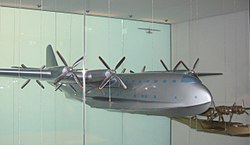Dornier Do 214
| Dornier Do 214 | |
|---|---|
 Model of the planned Do 214 |
|
| Type: | Flying boat |
| Design country: | |
| Manufacturer: | |
| Number of pieces: |
0 |
The Dornier Do 214 was a planned large civil flying boat for the Dornier-Werke .
The aircraft was designed from 1940 on behalf of Lufthansa as a large flying boat for passenger service in transatlantic traffic. Since the catapult launch seemed unreasonable for passengers, the aircraft should be able to take off without jump start. When awarding the contract, Dornier referred to previous designs such as the Dornier Do X or the Dornier Do 20 .
The aircraft was designed as a cantilever, full-metal shoulder-wing wing. The so-called Dornier stubs for stabilization in the water have been aerodynamically optimized. They were designed as bulges over the entire length of the hull. Further support swimmers were not planned. Eight Daimler-Benz DB 613s , each with 3500 hp, were to serve as the drive, each of which consisted of two Daimler-Benz DB 603 engines. A total of 16 engines were therefore planned. On each wing, there were two of the twin engines on the front and rear of the wing, two with pull propellers and two with push propellers. The engines were to be integrated into the very thick wing profiles, where they could be reached and serviced by the two on-board mechanics during the flight. The crew should consist of twelve men: the captain, two pilots, the navigator, a radio operator, two on-board mechanics, two stewards and two stewardesses and a reserve member.
The Do 214 was planned as a luxury aircraft and should - as far as possible - be equipped with a level of luxury similar to that of the airships of the time . A relatively small number of 40 passengers should be transported for the size of the aircraft. In the two-story fuselage, there was a lounge on the lower floor and two dining rooms on the upper floor.
The Reich Aviation Ministry stopped development in 1942 because the Do 214 was a civilian project. In order to be able to continue the work, the Do 214 was converted into a military project. For example, it was supposed to be used as a flying submarine base for the Navy. The following year the project was finally discontinued due to the war. The Dornier Do 216 project emerged from these considerations .
In 1940 only a reduced, manned model of the Do 214 in the scale 1: 5 was made. The machine, called Göppingen Gö 8 , was made entirely of wood and was used for towing and sailing experiments on the water.
Technical specifications
| Parameter | Data |
|---|---|
| crew | 12 |
| Passengers | 40 |
| length | 51.6 m |
| span | 60.0 m |
| height | 14.3 m |
| Wing area | 500 m² |
| Wing extension | 7.2 |
| Empty mass | 76,000 kg |
| Max. Takeoff mass | 145,000 kg |
| Top speed | 490 km / h |
| Service ceiling | 7000 m |
| Range | 6200 km |
| Engines | 8 × Daimler-Benz DB 613 , each 3,500 PS (approx. 2,600 kW) |
| Armament | 14 × SL 151 + HD 151, 4 × FDL 131, 1 × triple MG 131 (military version P192-01) |
See also
literature
- Heinz Nowarra : The German air armament 1933-1945. Bernard & Graefe Verlag, Koblenz 1993, ISBN 3-7637-5464-4 .